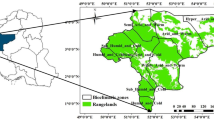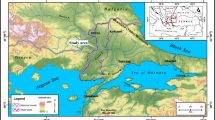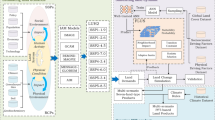Abstract
The effect of climate change on rangelands production in Iran is an important issue. This study aimed at parameterization and evaluation of SSM-iCrop2 and predicting spring re-growth and production of rangelands in current and future (under RCP4.5 and RCP8.5 climate change scenarios in 2050) conditions in Iran. The dry matter production data of 46 sites and the initiation date for spring growth of 34 sites in five rangeland types (Sahara-Sindian, semi-desert, steppe, semi-steppe, and high-mountainous) and three rangeland conditions (good, fair and poor) were used for parameterization and evaluation of the model. The results demonstrated that the model performed well and could predict rangeland production with a coefficient of variation of 18% and a correlation coefficient of 0.96. Simulation runs showed that climate change will affect growth and production of rangelands. In a way that the current 10.86 million ton average rangeland production of the country was estimated 6.9 and 4.8 percent less in RCP4.5 and RCP8.5, respectively. Furthermore, the average spring re-growth decreased from 73 days after first of January in the current condition to 66 and 61 days after January in RCP4.5 and RCP8.5 scenarios, respectively. Growth and production were closely linked to temperature and precipitation changes. Also, the increase in CO2 concentration modulated the negative effects of climate change. Ultimately, it can be concluded that SSM-iCrop2 model has the ability to simulate large-scale rangeland production with a relatively simple approach.





Similar content being viewed by others
References
Allen VG, Batello C, Berretta EJ, Hodgson J, Kothmann M, Li X, McIvor J, Milne J, Morris C, Peeters A, Sanderson M (2011) An international terminology for grazing lands and grazing animals. Grass Forage Sci 66:2–28
Arzani H, Mirdavoodi H, Farahpour M et al (2005) Trends in vegetation change and production in Markazi Province during a 5-Year Period. IRDRQ 12:409–420
Askarizadeh D, Arzani H, Jaffari M, Bazrafshan J (2018) Surveying of the past, present and future of vegetation changes in the central Alborz ranges in relation to climate change. J GIS RS for Natur Res 3:1–18
Azimi M, Heshmati GA, Farahpour M et al (2013) Modeling the impact of rangeland management on forage production of sagebrush species in arid and semi-arid regions of Iran. Ecol Modell 250:1–14
Backlund P, Janetos A, Schimel D (2008) The effects of climate change on agriculture, land resources, water resources, and biodiversity in the United States. Synthesis and Assessment Product 4.3. Washington, DC: US Environmental Protection Agency, Climate Change Science Program
Badeck FW, Bondeau A, Bottcher K et al (2004) Responses of spring phenology to climate change. New Phytol 162:295–309
Bork EW, Thomas T, McDougall B (2001) Herbage response to precipitation in central Alberta boreal grasslands. Rangel Ecol Manag 54:243–248
Coppock DL, Fernández-Giménez M, Hiernaux P et al (2017) Rangeland systems in developing nations: conceptual advances and societal implications. Rangel Syst 2017:569–642
Corson MS, Skinner RH, Rotz CA (2006) Modification of the SPUR rangeland model to simulate species composition and pasture productivity in humid temperate regions. Agric Syst 87:169–191
CSIRO (2004) Report of natural resource models in the rangelands, A review undertaken for the national land and water resources audit. An Australian Government Initiative
Daneshvar M, Ebrahimi M, Nejadsoleymani H (2019) An overview of climate change in Iran: facts and statistics. Environ Syst Res 8:1–10
de Dios MJ, Padilla FM, Pugnaire FI (2009) Response of a Mediterranean semiarid community to changing patterns of water supply. PPEES 11:255–266
Dile Y, Srinivasan R (2014) Evaluation of CFSR climate data for hydrologic prediction in data-scarce watersheds: an application in the Blue Nile River Basin. JAWRA 50(5):1226–1241
Dror D, Allen L (2011) The importance of milk and other animal-source foods for children in low-income countries. FNB 32:227–243
Ehleringer JR, Schwinning S, Gebauer R (1999) Water use in arid land ecosystems. J Plant Ecol 1999:347–365
Fakhimi E, Arzani H, Soltani M, Faramarzi G (2018) Investigating the efficiency of water balance model in estimating long-term rangeland production (Case study: steppe rangelands of Shir Kooh area of Yazd). Rangel J 12:519–531
Farokhi H, Mohtashamnia M, Abbasizade M (2020) Production is estimated using significant steppe rangelands of Yazd Case Study (Sadrabad pastures Nodoushan Yazd). Plant ecoph 12:86–94
Foy JK, Teague R, Hanson JD (1999) Evaluation of the upgraded SPUR model (SPUR2.4). Ecol Modell 118:149–165
FRWMOI (2020) http://www.frw.ir/02/En/default.aspx Accessed 8 Jul 2020.
Fuka DR, MacAllister CA, Degaetano AT, Easton ZM (2013) Using the climate forecast system reanalysis dataset to improve weather input data for watershed models. Hydrol 5623:5613–5623
Godde C, Boone RB, Ash AJ et al (2020) Global rangeland production systems and livelihoods at threat under climate change and variability. Environ Res Lett 15:044021
Godde C, Dizyee K, Ash A et al (2019) Climate change and variability impacts on grazing herds: insights from a system dynamics approach for semi-arid Australian rangelands. Glob Chang Biol 25:3091–3109
Headey D, Hirvonen K, Hoddinott J (2018) Animal sourced foods and child stunting. J Agric Econ 100:1302–1319
Hoogenboom G, Jones JW, Wilkens PW et al (2004) Decision support system for agrotechnology transfer version 4.0. University of Hawaii, Honolulu, HI (CD-ROM)
Hounet Y, Brisebarre AM, Guinand S (2016) The cultural heritage of pastoralism—local knowledge, state identity and the global perspective: the example of local breeds in Morocco. Rev sci tech 35:357–370
Howden SM, Crimp SJ, Stokes CJ (2008) Climate change and its effect on Australian livestock systems. Aust J Exp Agric 48:780–788
IPCC (2007) Climate change 2007: the physical science basis. Agenda 6:333
Jaberalansar Z, Tarkesh M, Bassiri M, Pourmanafi S (2017) Modelling the impact of climate change on rangeland forage production using a generalized regression neural network: a case study in Isfahan Province, Central Iran. J Arid Land 9:489–503
Jones MO, Robinson NP, Naugle DE (2021) Annual and 16-day rangeland production estimates for the western United States. Rangel Ecol Manag 77:112–117
Koo J, Dimes J (2013) HC27 generic soil profile database. Harvard Dataverse Ver. 4. International Food Policy Research Institute: Washington, DC, USA
Laflen JM, Elliot WJ, Simanton JR et al (1991) WEPP: Soil erodibility experiments for rangeland and cropland soils. JSWC 46:39–44
Liu J, Wiberg D, Zehnder AJB, Yang H (2007) Modeling the role of irrigation in winter wheat yield, crop water productivity and production in china. Irrig Sci 26:21–33
Marshall NA (2015) Adaptive capacity on the northern Australian rangelands. Rangel J 37:617–622
Ministry Of Agriculture Jahad (2017) https://www.maj.ir/index.aspx?tempname=NewEnMain&lang=2&sub=0 Accessed 10 Jul 2020
Mo X, Liu S, Lin Z et al (2005) Predicting of crop yield, water consumption and water use efficiency with a SVAT-crop growth model using remotely sensed data on the North China Plain. Ecol Modell 183:301–322
Mohtar R, Buckmaster DR, Fales SL (1997) A grazing simulation model: GRASIM, a model development. Trans ASAE 40:1483–1493
Mohtar R, Zhai T, Chen X (2000) A world wide web-based grazing simulation model (GRASIM). Comput Electron Agric 29:243–250
Moqimi J (2019) Introducing and criticizing the collection of books related to the national plan for determining harvestable forage from rangelands in Iran. INJ 4:115–120
Morgan JA, Pataki DE, Körner C et al (2004) Water relations in grassland and desert ecosystems exposed to elevated atmospheric CO2. Oecologia 140:11–25
Munkhtsetseg E, Kimura R, Wang J, Shinoda M (2007) Pasture yield response to precipitation and high temperature in Mongolia. J Arid Environ 70:94–110
Nehbandani A, Soltani A, Taghdisi Naghab R et al (2020) Assessing HC27 soil database for modeling plant production. IJPP 14:679–687
Noy-Meir I (1973) Desert ecosystems: environment and producers. Annu Rev Ecol Evol Syst 4:25–51
Parsch LD, Loewer OJ (1995) GRAZE Beef-Forage Simulation Model: User Guide Leditors. University of Arkansas
Polley HW, Bailey DW, Nowak RS, Stafford-Smith M (2017) Ecological consequences of climate change on rangelands. Rangel Syst 2017:229–260
Riahi K, Rao S, Krey V et al (2011) RCP 8.5—A scenario of comparatively high greenhouse gas emissions. Clim Change 109:33–43
Rotz CA, Corson MS, Chianese DS et al (2012) The integrated farm system model reference manual, Version 3.6. USDA-Agricultural Research Service
Ruane AC, Winter JM, McDermid SP, Hudson NI (2015) AgMIP climate data and scenarios for integrated assessment. Handbook of Climate Change and Agroecosystems: The Agricultural Model Intercomparison and Improvement Project 45–78
Sayre NF, McAllister RR, Bestelmeyer BT, Moritz M, Turner MD (2013) Earth Stewardship of rangelands: coping with ecological, economic, and political marginality. Front Ecol Environ 11:348–354
Sharifi J, Akbarzadeh M (2013) Investigation of vegetation changes under precipitation in semi-steppic rangelands of Ardebil province (Case study: Arshagh Rangeland Research Site). J Watershed Manag Res 65:507–516
Shaw MR, Pendleton L, Cameron DR et al (2011) The impact of climate change on California’s ecosystem services. Clim Change 109:465–484
Soltani A, Alimagham SM, Nehbandani A et al (2020) Future food self-sufficiency in Iran: a model-based analysis. Glob Food Sec 24:100351
Soltani A, Sinclair TR (2012) Modeling physiology of crop development, growth and yield. CABi
Soltani A, Alimagham SM, Nehbandani A et al (2020) SSM-iCrop2: A simple model for diverse crop species over large areas. Agric Syst 182:102855
Souri M, Bayat M, Arzani H, Khodagholi M (2020) Estimation of long-term forage production of steppe rangelands of Fars province based on climatic factors parameters. J Watershed Manag Res 72:995–1009
Thomson AM, Calvin KV, Smith SJ et al (2011) RCP4. 5: a pathway for stabilization of radiative forcing by 2100. Clim Change 109:77–94
Torell LA, McDaniel KC, Koren V (2011) Estimating grass yield on blue grama range from seasonal rainfall and soil moisture measurements. Rangel Ecol Manag 64:56–66
Van Wart J, van Bussel LGJ, Wolf J et al (2013) Use of agro-climatic zones to upscale simulated crop yield potential. Field Crops Res 143:44–55
Wei Y, Ruiqing G, Xuebiao P, Buju L (2008) The effect of climate change on livestock carrying capacity of Inner Mongolia. Multifunctional Grasslands in a Changing World
Williams JR (1995) The EPIC model. computer models of watershed hydrology. Water Resourc Publ Highl Ranch 25:909–1000
Yahdjian L, Sala OE (2008) Climate change impacts on South American rangelands. Rangelands 30:34–39
Funding
This research received no specific grant from any funding agency, commercial or not-for-profit sectors.
Author information
Authors and Affiliations
Corresponding author
Ethics declarations
Conflict of Interest
The authors declare there are no conflicts of interest.
Additional information
Publisher's Note
Springer Nature remains neutral with regard to jurisdictional claims in published maps and institutional affiliations.
Supplementary Information
Below is the link to the electronic supplementary material.
Rights and permissions
Springer Nature or its licensor (e.g. a society or other partner) holds exclusive rights to this article under a publishing agreement with the author(s) or other rightsholder(s); author self-archiving of the accepted manuscript version of this article is solely governed by the terms of such publishing agreement and applicable law.
About this article
Cite this article
Nehbandani, A., Barani, H., Soltani, A. et al. Estimating Rangeland Production in Current and Future Conditions Using SSM-iCrop2 Model in Iran. Agric Res 12, 346–355 (2023). https://doi.org/10.1007/s40003-023-00652-z
Received:
Accepted:
Published:
Issue Date:
DOI: https://doi.org/10.1007/s40003-023-00652-z




